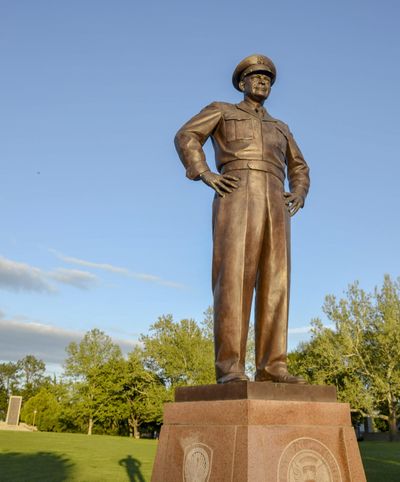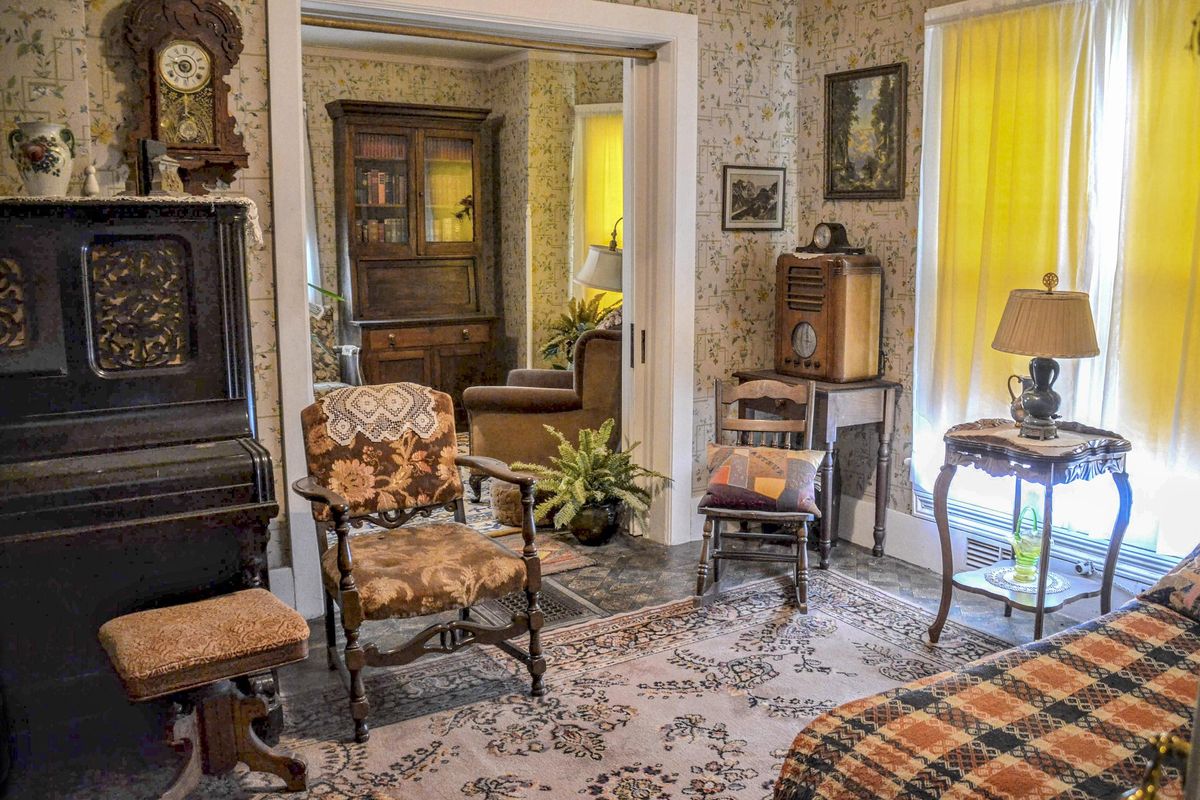In the Kansas town that was home, the astonishing story of Eisenhower lives on

ABILENE, Kan. – They still like Ike in Abilene.
And why not? He executed the military plan that turned the tide of World War II in Europe, stopped Hitler and ultimately brought the war in that theater to an end. He did it by getting big-ego military leaders to work together by subjugating his own, by believing in his troops, by being willing to take all of the blame if it failed and none of the credit if it worked.
That he was the driving force behind the biggest invasion modern generations have known is made more stunning by knowing his hardscrabble story began not in Kansas but in Texas and ended not in Kansas but in Pennsylvania.
But Abilene is where Eisenhower’s story is laid out for anyone to see.
Dwight David Eisenhower was born Oct. 14, 1890, in Denison, Texas, but father David and mother Ida soon moved the family to Abilene, a rowdy town once known as the end point for long-horn cattle drives. It’s hard to believe now as you drive Abilene’s quiet streets dotted with stately Victorian homes, but one town marshal is said to have killed 50 miscreants. His name: Wild Bill Hickok.
Abilene had calmed down considerably by the time the Eisenhowers moved here, but there was still plenty of mischief for six rascally boys who grew up on what was considered the wrong side of the tracks. (Fifth son Paul died of diphtheria at 10 months.)
“Bruises and emergencies were normal in a household of six boys who were convinced that they could outwit such small considerations as the law of gravity,” Eisenhower wrote in “At Ease: Stories I Tell My Friends.”
The family eventually settled into a permanent home in Abilene in 1898, and it is that house that visitors can walk through on a visit there.
David and Ida were religious, their leanings influenced by a Pennsylvania branch of the Mennonites, and Bible readings were a constant in daily life. So was cooking; Ida was said to have made 27 loaves of bread a week to feed her young brood and taught each of the boys to cook and sew.

Education was prized. Both parents had graduated from college (a rarity in those days, rarer still for a woman), but because they were poor, the brothers often worked to support another brother who was in college.
Dwight, a good student and a better athlete, learned from his pal Edward “Swede” Hazlett that attending a service academy meant a free university education. He set his sights on the U.S. Naval Academy but was too old for admission; he turned instead to West Point.
Suddenly, a young man from a pacifist family and no military tradition was headed to New York to join a group of men who would graduate in 1915. They became known as “the class the stars fell on.” Fifty-nine of the 164 achieved the rank of general.
The early story of Eisenhower comes to life at the family home, but the rest of Eisenhower’s story will be told in a slightly different way when the $10-million redo of the museum is unveiled at the end of July. The work was to have been completed before June 6, the 75th anniversary of D-day, but the 35-day partial government shutdown that ended Jan. 25 put an end to that.
But not to the desire to tell the story of Ike and Mamie Eisenhower, the vivacious young woman from Denver whom Eisenhower wed in 1916. In many ways, they completed each other – he the serious student of the military, she the ideal hostess, wife and mother. “Without Mamie,” said curator William Snyder, “there is no Ike.”
But with Ike overseas during the war, Mamie was anxious, as revealed in their mostly affectionate, occasionally strained letters. She was aware of the rumors about Kay Summersby, Ike’s British driver and secretary. Tension was understandably heightened when their son John, also a West Point graduate, wound up in war-torn Europe, writes Stephen E. Ambrose in “Eisenhower: Soldier and President.” (Their first son, Doud Dwight, born in 1921, died of diphtheria at age 3.)
Eisenhower had trained for the role he eventually was given – supreme commander of the Allied expeditionary force – all of his adult life. He missed battlefield action in World War I and was convinced he would never advance beyond the rank of lieutenant colonel.
In the end, his training and skills qualified him for the post, but it may have been his temperament that put him at the command fore. His job was to win the war; his unseen job was to get the leaders of American, British and Canadian forces to control their egos, quit squabbling and execute the plan that would break Germany’s back.
Allied commanders, including Ike, sat around a 19th century table to draw and redraw the invasion plan. This Sheraton table will soon be on display again – this time with all its leaves – in the museum, surrounded by 10 of the original 12 Chippendale chairs. (One of the chairs is in a museum in Europe, and the other is with a family member.)
To appreciate the plotting and planning for the invasion of Normandy, France, consider the numbers that crossed the English Channel: 12,000 or more aircraft, 6,500 oceangoing craft, more than 150,000 troops and 200,000 vehicles. And that was just the beginning of a fight that took nearly a year to complete.
To appreciate Eisenhower, consider what he wrote. His order of the day, delivered to all fighting forces before the invasion, said this, in part: “I have full confidence in your courage, devotion to duty and skill in battle. We will accept nothing less than full victory!
“Good luck! And let us all beseech the blessing of Almighty God upon this great and noble undertaking.”
This expression of absolute faith in his warriors masked a million worries. The other note he kept in his pocket, to be delivered in case the invasion failed, did not: ”Our landings in Cherbourg-Havre area have failed to gain a satisfactory foothold, and I have withdrawn the troops. My decision to attack at this time and place was based on the best information available. The troops, the air and the Navy did all that bravery and devotion to duty could do. If any blame or fault attaches to the attempt it is mine alone.“
The presidential library and museum ended up in Abilene because a veterans museum was planned near the boyhood home. When Eisenhower became president in 1952, it became a practical matter to place a presidential library and museum here.
An unexpected choice, perhaps, but the right one. This is where Eisenhower, a Republican, announced his run for a presidency that would last eight years, six with a Congress controlled by Democrats; grapple with a changing postwar America, the Cold War and civil rights. His message is immutable: Work and study hard. Play hard. Be fair. Have faith. Keep your eye on a greater goal. Service before self.
“There’s no ego, there’s no agenda,” Snyder said of Ike. “He was humble enough to talk about, ‘We did so much for the country’ – and it wasn’t ‘I did’; it was ‘We did.’ It was always ‘we’ unless he had to take responsibility, and then it’s ‘I.’ ”